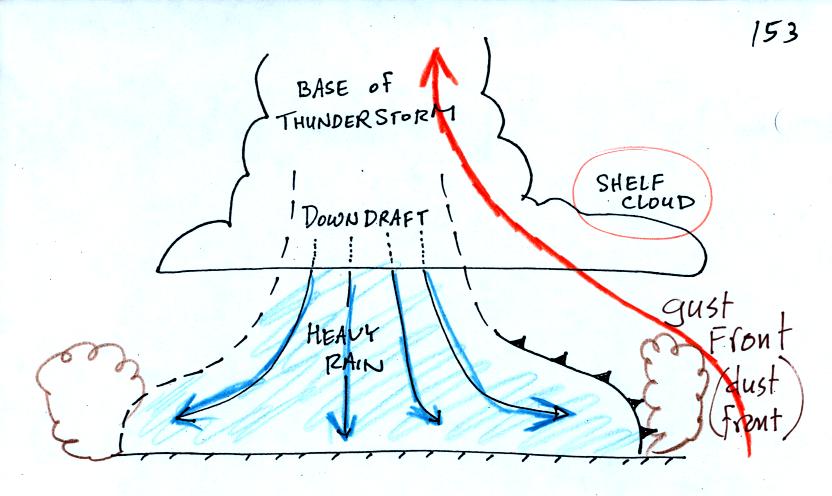

The cold downdraft air spilling out of a
thunderstorm hits the ground
and
begins to move outward from underneather
the
thunderstorm. The leading edge of this outward moving air is
called a
gust front. You can think of it as a dust front because the gust
front
winds often stir up a lot of dust here in the desert southwest.
Warm moist air lifted by the gust front can form a shelf cloud.
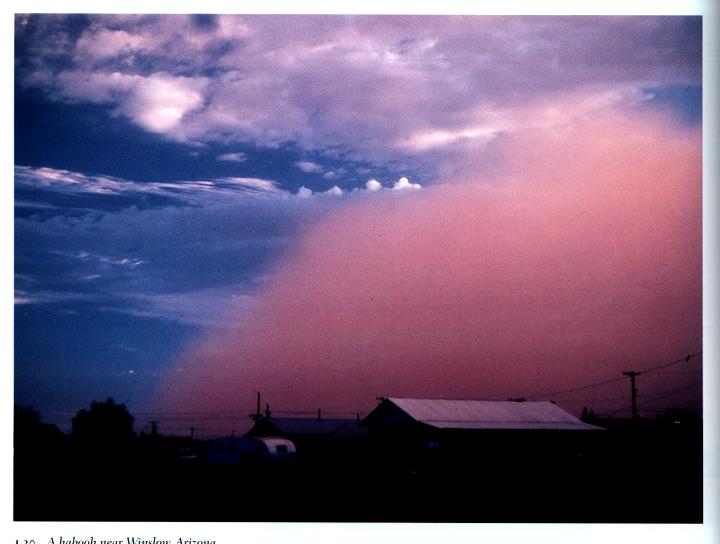
This
is a picture of a dust cloud stirred up by thunderstorm gust front
winds (taken
near
The following picture shows a shelf cloud.
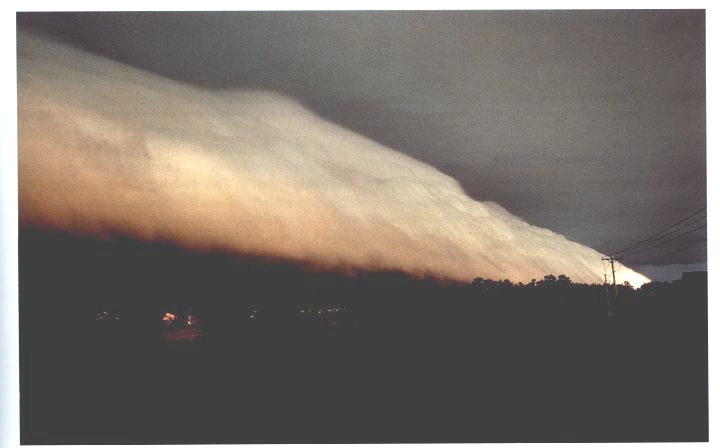
The gust front is
moving from left
to right in this picture. The shelf cloud is very close to the
ground, so
the warm air that was lifted by the gust front must have been very
moist.
It didn't have to rise and cool much before it became saturated and a
cloud
formed.

A narrow intense downdraft is called a microburst. At the ground
microburst winds will sometimes reach 100 MPH (over a limited area);
most
tornadoes have winds of 100 MPH or less. Microburst winds can
damage
homes (especially mobile homes that aren't tied to the ground), uproot
trees,
and seem to blow over a line of electric power poles at some point
every summer
in
Microbursts are a serious threat to
aircraft
especially when they are close to the ground during landing or
takeoff.
An inattentive pilot encountering headwinds at Point 1 might cut back
on the
power. Very quickly the plane would lose the headwinds (Point 2)
and then
encounter tailwinds (Point 3). The plane might lose altitude so
quickly
that it would crash into the ground before corrective action could be
taken.
Falling rain could warn of a (wet) microburst. In other cases,
dangerous
dry microburst winds might be invisible (the virga,
evaporating rain, will cool the air, make the air more dense, and
strengthen
the downdraft winds).
A simple demonstration can give you an idea of what a microburst might
look
like.
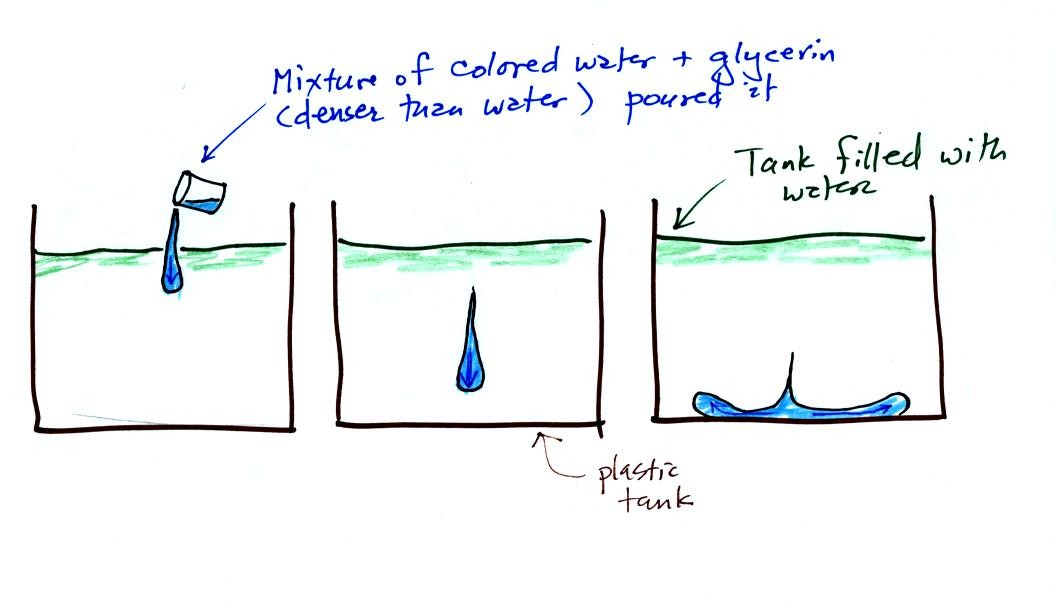
A large plastic
tank was filled
with water, the water represents air in the
atmosphere. Then a colored mixture of water and glycerin, which
is a
little denser than water, is poured into the tank. This
represents the
cold dense air in a thunderstorm downdraft. The colored liquid
sinks to
the bottom of the tank and then spreads out horizontally. In the
atmosphere the cold downdraft air hits the ground and spreads out
horizontally. These are the strong winds that can reach 100 MPH.
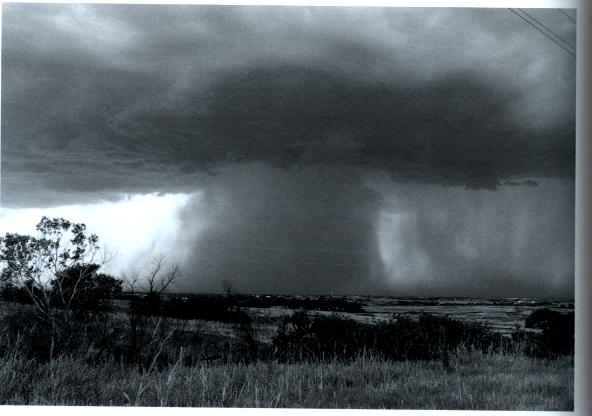
Here's
a picture of a wet microburst, a narrow intense thunderstorm downdraft
and
rain.
Next we looked
at some of the conditions that can lead to severe thunderstorm
formation and at some of the features that allow severe storms to last
longer, grow bigger, and become stronger than ordinary air mass
thunderstorms.
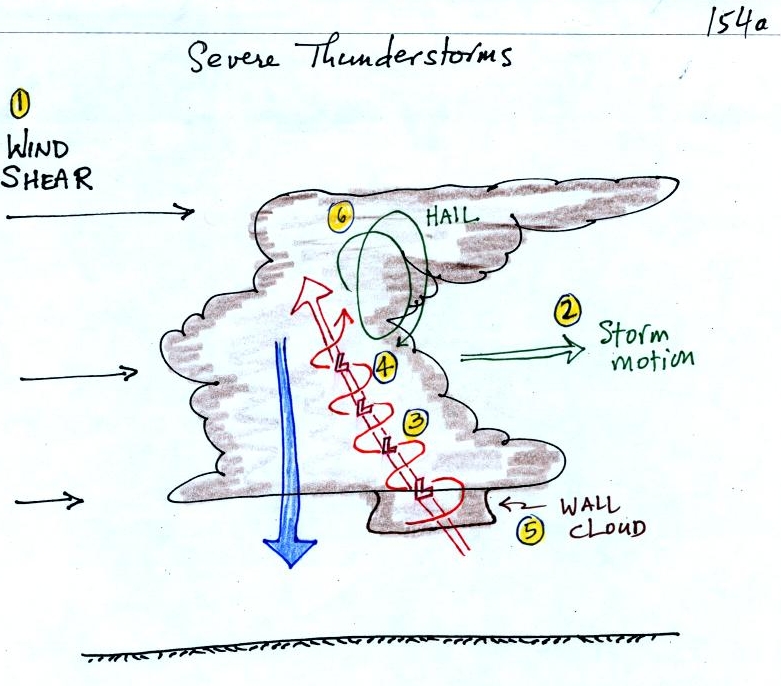
Severe
storms are more likely to form when there is vertical wind shear.
Wind
shear (pt 1) is changing wind direction or wind speed with
distance. In
this case, the wind speed is increasing with increasing altitude, this
is vertical wind shear.
The thunderstorm itself will move in this kind of an environmen,
at an average of the speeds at the top and bottom of the cloud (pt.
2).
The thunderstorm will move to the right more rapidly than the air at
the ground
which is where the updraft begins. Rising air that is situated at
the
front bottom edge of the thunderstorm will find itself at the back edge
of the
storm when it reaches the top of the cloud. This produces a
tilted
updraft (pt. 3). The downdraft is situated at the back of the
ground. The updraft is continually moving to the right and
staying away
from the downdraft. The updraft and downdraft coexist and do not
"get in each others way." If you remember in air mass
thunderstorms, the downdraft gets in the way of the updraft and leads
to dissipation of the storm.
Sometimes the tilted updraft will begin to rotate. A rotating
updraft is
called a mesocyclone (pt. 4). Meso refers to medium size (thunderstorm size)
and cyclone
means winds spinning around low pressure. Low pressure in the
core of the
mesocyclone creates an inward pointing
pressure
gradient force needed to keep the updraft winds spinning in circular
path (low
pressure also keeps winds spinning in a tornado). The cloud that
extends
below the cloud base and surrounds the mesocyclone
is
called a wall cloud (pt. 5). The largest and strongest tornadoes
will
generally come from the wall cloud.
Note (pt. 6) that a tilted updraft provides a way of keeping growing
hailstones
inside the cloud. Hailstones get carried up toward the top of the
cloud
where they begin to fall. But they then fall
back into
the strong core of the updraft and get carried back up toward the top
of the
cloud.
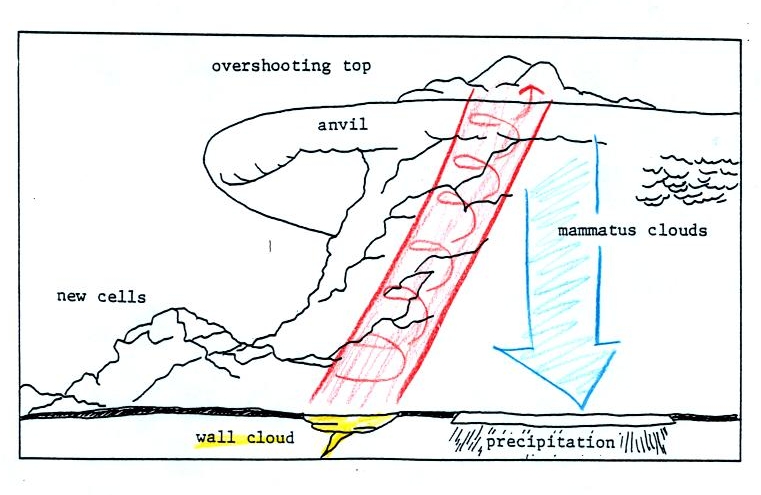
Here is a
relatively simple
drawing showing some of the key features on a supercell
thunderstorm. In a supercell the
rotating
updraft (shown in orange above) is strong enough to penetrate into the
stratosphere. This produces the overshooting top or dome feature
above. A wall cloud and a tornado are shown at the bottom of the mesocyclone. In an ordinary thunderstorm
the updraft
is unable to penetrate into the very stable air in the stratosphere and
the
upward moving air just flattens out and forms an anvil. The
flanking line
is a line of new cells trying to form alongside the supercell
thunderstorm.
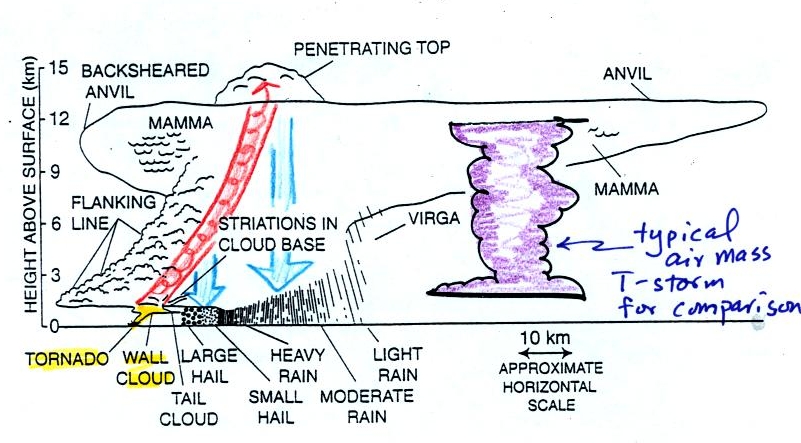
Here
is a second slightly more complicated drawing of a supercell
thunderstorm. A typical air mass thunderstorm (purple) has been
drawn in
for comparison.
A short segment
of video was shown at this point. The video first showed some
good quality video of a close tornado. We will be covering
tornadoes in class on Friday. This was followed by photographs of
a distant supercell thunderstorm and photographs of the bases of nearby
supercell thunderstorms. Here you could see the spectacular wall
cloud that often forms at the base of these storms. Finally a
computer simluation showed some of the complex motions that form inside
supercell thunderstorms, particularly the tilted rotating updraft.
Thunderstorms
with rotating updrafts often have a distinctive radar signature.
We haven't
discussed weather radar
in this class. In some ways a radar image of a thunderstorm is
like an
X-ray photograph of a human body. The Xrays
pass through the flesh but are partially absorbed by bone.
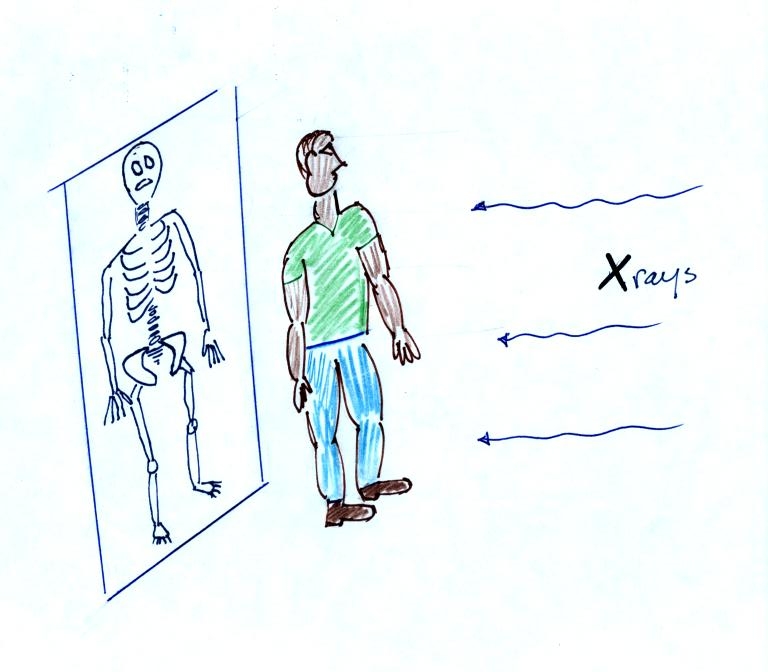
The radio signals emitted by radar pass through the cloud itself but are reflected by the much larger precipitation particles. The intensity of the reflected signal (the echo) is color coded. Red means an intense reflected signal and lots of large precipitation particles. The edge of the cloud isn't normally seen on the radar signal.
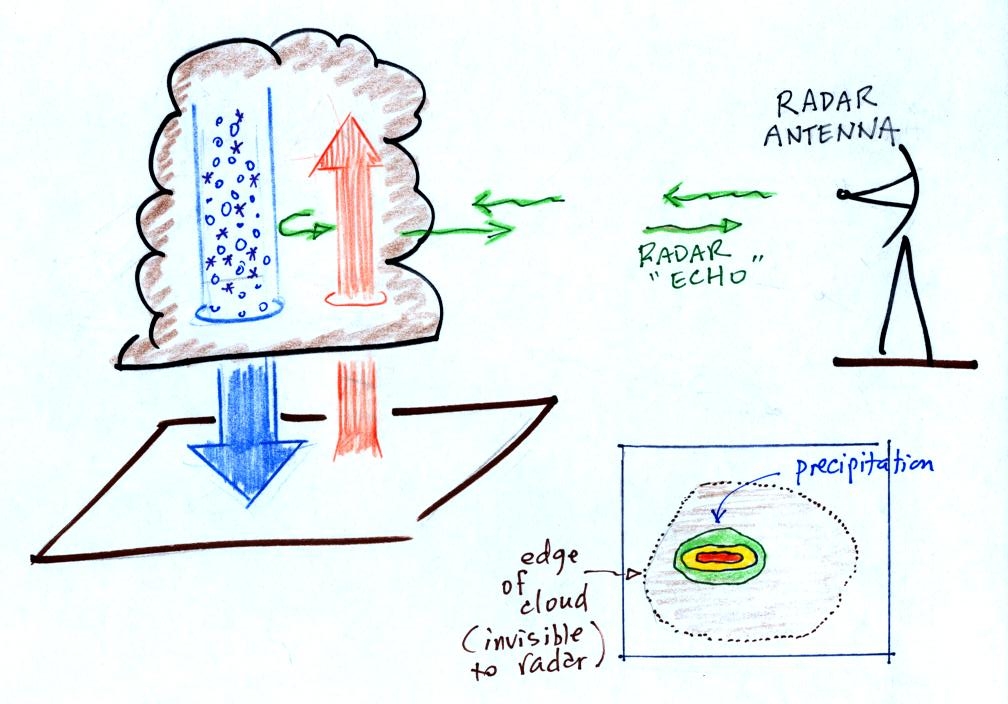
Thunderstorms
with rotating
updrafts produce a very characteristic hook shaped echo on
radar.
Here
are a couple of examples:


This is the radar image of a very strong tornado that hit
( http://www.spc.noaa.gov/faq/tornado/radscel.htm
). The hook echo is visible near the lower left hand
corner of the picture. A very strong tornado. It is
possible that winds in the tornado may have exceeded 300 MPH.
We watched a short video segment at this point. It showed a
photograph of
a distant supercell thunderstorm with a
distinctive
dome. The video showed the wall clouds at the bottoms of 2 or 3
other
much closer supercells. And finally
a computer
simulation of the air motions inside a supercell
thunderstorm was shown. Researchers understand the development of
a supercell pretty well. The exact
process that
initiates tornado development is still unknown, however.